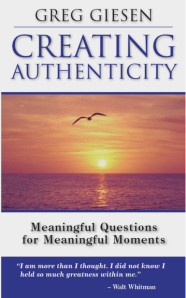It’s easy to lose sight of the true meaning of Thanksgiving amongst all the parties, the rituals, the football games, the cooking, and the family dynamics. And yet it’s the perfect opportunity to reflect a little on our lives and to acknowledge all the people and experiences that have positively impacted us the most!
Not to worry! I’ve found a way to do both.
Using selected questions from my book, Creating Authenticity: Meaningful Questions for Meaningful Moments, I’ve created a fun and meaningful activity for you to do with your friends and family at the dinner table that will make this a Thanksgiving to remember.

Why do we need a Thanksgiving activity, you ask?
You don’t. However, if your Thanksgiving conversations with your friends and family have a tendency to migrate towards football, weather, politics, and gossip, perhaps it’s time for a change. Perhaps it’s time for some meaningful and introspective conversation with each other that come from the heart. After all, isn’t that ultimately what Thanksgiving is all about?
Below are 50 questions that will spark great conversation and gratitude. My simple suggestion would be to:
· Copy this blog and paste it on a separate page.
· Enlarge the type.
· Cut out all the questions individually, or at least all the questions you want to be a part of this activity.
· Place the questions in a container of some kind.
· When it’s time to begin the exercise, pass the container around, having each person select a question.
· Go around the table (once or multiple times) and ask each person to then read their question and answer it.
· Feel free to alter this activity to fit your group.
Questions
1. If you were told today that you had a month left to live, what would you want to do with the remaining time?
2. What friendships have meant the most to you and why?
3. What do you still want to do in your life that you haven’t yet done?
4. What qualities do your closest friends have in common?
5. What’s something crazy that you can still see yourself doing?
6. What is one of the biggest obstacles you have had to overcome in your life? Please explain.
7. What do most people who you know not know about you?
8. What do you wish you were better at and why?
9. What is one of your biggest regrets in life and why?
10.What kind of kid were you growing up? How have you changed?
11.What’s a recent accomplishment that you are most proud of and why?
12.What are you most passionate about in your life and how would someone know it?
13.What’s probably the biggest risk you ever took and how did it turn out?
14.What’s been the most meaningful feedback you’ve ever received and what did you do with it?
15.Describe your most meaningful possession.
16.When given the opportunity, what do you brag about most and why?
17.What is one of the best compliments you’ve received this year?
18.What memory still makes you laugh when you think about it?
19.When is the last time you felt most alive? What was happening?
20.What’s been some of the best advice you’ve ever received and how has it helped you?
21.What qualities do you find attractive in other people?
22.If you could clone yourself exactly as you are today, but have the ability to change one thing, what would you change?
23.Which of the television shows that you currently watch tells the most about you?
24.Who was your all-time favorite teacher and why?
25.Which of your physical features do you get complimented on the most?
26.What past or present photograph in your home means the most to you and why?
27.If you could re-live (but not change) a past moment in your life, what moment would that be and why?
28.When was the last time you laughed so hard that your stomach hurt?
29.Describe the perfect romantic evening.
30.Which of your childhood possessions had the most meaning for you and why?
31.You have just commissioned a famous painter to do a painting for you. What are you going to have them paint?
32.Who, among the people your life do you admire the most and why?
33.Complete this sentence: Sometimes I wish…
34.Which of your hobbies probably tells the most about you?
35.What causes you the most stress? How would people know?
36.What’s one of the best decisions you’ve made in this past year and why?
37.How would you define a successful life? How does your life compare?
38.What was one of the most courageous things you have ever done?
39.In what ways are you misunderstood?
40.Complete this sentence: Sometimes I pretend…
41.What is the most important thing you’d like to learn next?
42.What would you like to have more of in your life?
43.What would you like to have less of in your life?
44.Of all the cars you’ve owned over the years, which one holds the best memories for you?
45.If your life goes exactly the way you would like it to go, what will you be doing five years from now?
46.What would you like to hear more of that you don’t hear enough?
47.What do you think attracts most people to you?
48.What is one of your favorite traditions that you still observe today? Please explain.
49.What’s been the most exciting thought occupying your mind lately?
50.What three things are you most thankful for and why?
Remember, the idea here is to have an activity that everyone can participate in. With that said, it’s also important to allow people the option of skipping their turn if they are not comfortable playing. Simply leave it up to them.
Let me know how it goes.

And, have a happy Thanksgiving!
P.S. If you like the process, go to www.thelaughingleader.com or CLICK HERE and download my free New Years Resolutions That Stick! workbook to get a similar New Year’s Eve activity. It’s free after all!








